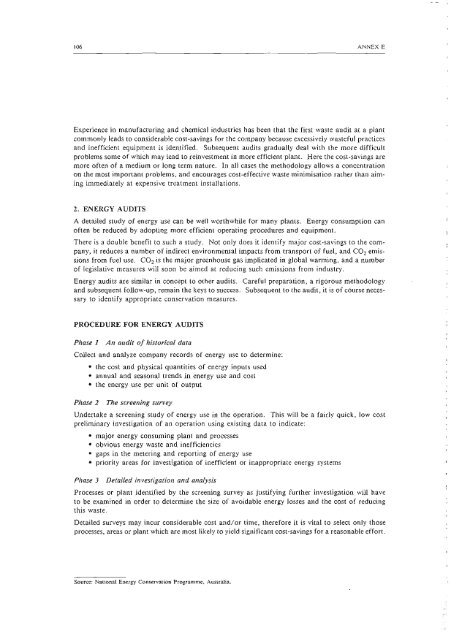Contributor, The Textile Industry and the Environment, UNEP
Contributor, The Textile Industry and the Environment, UNEP
Contributor, The Textile Industry and the Environment, UNEP
You also want an ePaper? Increase the reach of your titles
YUMPU automatically turns print PDFs into web optimized ePapers that Google loves.
106 ANNEX E<br />
Experience in manufacturing <strong>and</strong> chemical industries has been that <strong>the</strong> first waste audit at a plant<br />
commonly leads to considerable cost-savings for <strong>the</strong> company because excessively wasteful practices<br />
<strong>and</strong> inefficient equipment is identified. Subsequent audits gradually deal with <strong>the</strong> more difficult<br />
problems some of which may lead to reinvestment in more efficient plant. Here <strong>the</strong> cost-savings are<br />
more often of a medium or long term nature. In all cases <strong>the</strong> methodology allows a concentration<br />
on <strong>the</strong> most important problems, <strong>and</strong> encourages cost-effective waste minimisation ra<strong>the</strong>r than aiming<br />
immediately at expensive treatment installations.<br />
2. ENERGY AUDITS<br />
A detailed study of energy use can be well worthwhile for many plants. Energy consumption can<br />
often be reduced by adopting more efficient operating procedures <strong>and</strong> equipment.<br />
<strong>The</strong>re is a double benefit to such a study. Not only does it identify major cost-savings to <strong>the</strong> company,<br />
it reduces a number of indirect environmental impacts from transport of fuel, <strong>and</strong> CO 2 emissions<br />
from fuel use. CO 2 is <strong>the</strong> major greenhouse gas implicated in global warming, <strong>and</strong> a number<br />
of legislative measures will soon be aimed at reducing such emissions from industry.<br />
Energy audits are similar in concept to o<strong>the</strong>r audits. Careful preparation, a rigorous methodology<br />
<strong>and</strong> subsequent follow-up, remain <strong>the</strong> keys to success. Subsequent to <strong>the</strong> audit, it is of course necessary<br />
to identify appropriate conservation measures.<br />
PROCEDURE FOR ENERGY AUDlTS<br />
Phase 1 An audit of historical data<br />
Collect <strong>and</strong> analyze company records of energy use LO determine:<br />
• <strong>the</strong> cost <strong>and</strong> physical quantities of energy inputs used<br />
• annual <strong>and</strong> seasonal trends in energy use <strong>and</strong> cost<br />
• <strong>the</strong> energy use per unit of output<br />
Phase 2 <strong>The</strong> screening survey<br />
Undertake a screening study of energy use in <strong>the</strong> operation. This will be a fairly quick, low cost<br />
preliminary investigation of an operation using existing data to indicate:<br />
• major energy consuming plant <strong>and</strong> processes<br />
• obvious energy waste <strong>and</strong> inefficiencies<br />
• gaps in <strong>the</strong> metering <strong>and</strong> reporting of energy use<br />
• priority areas for investigation of inefficient or inappropriate energy systems<br />
Phase 3 Detailed investigation <strong>and</strong> analysis<br />
Processes or plant identified by <strong>the</strong> screening survey as justifying funher investigation will have<br />
to be examined in order to determine <strong>the</strong> size of avoidable energy losses <strong>and</strong> <strong>the</strong> cost of reducing<br />
this waste.<br />
Detailed surveys may incur considerable cost <strong>and</strong>/or time, <strong>the</strong>refore it is vital to select only those<br />
processes, areas or plant which are most likely to yield significant cost-savings for a reasonable effort.<br />
Source: National Energy Conservation Programme. Australia.

















